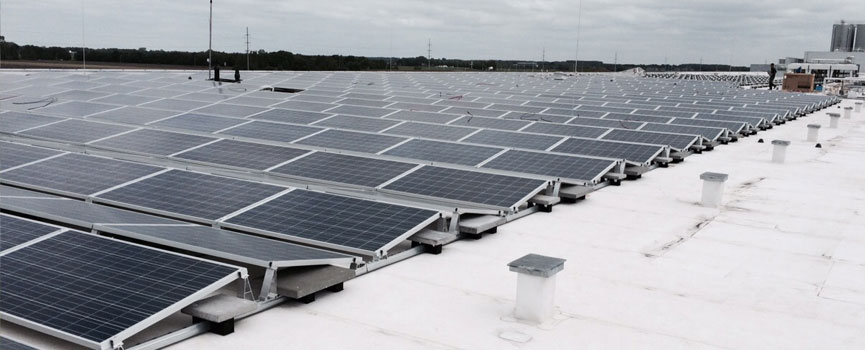- HOME
- ABOUT US
- SOLUTIONS
- Metal Roof PV Mounts and Systems
- Flat Roof Solar Panel Mounting Systems Solutions
- Tile Roof Solar Mounting Systems Solutions
- Solar Tracking Solutions for Commercial PV Projects
- Ground Solar Mounting Systems Solutions
- Floating Solar Solutions - PV Systems
- PV Solar Carport Mounting Systems Solutions
- Balcony Solar Panel Mounting Systems Solutions
- PRODUCTS
- PROJECTS
- COMPANY NEWS
- BLOG
- Contact Us

Solar panel installation on a flat roof does not have to involve drilling holes in the roof and risking leaks. Other methods of attaching solar panels to a flat roof that are equally secure and can save you time and money are available.
The Advantages of Putting Solar Panels on Flat Roofs
Solar panels are becoming more popular as a means of generating renewable energy. Solar panels have the advantage of being able to be installed on a variety of rooftops, including flat roofs. While pitched roofs are commonly thought to be the best place for solar panels, there are several advantages to installing them on a flat roof.
1. In general, flat roofs are less expensive to install than pitched roofs.
2. Flat roofs have fewer obstacles to block sunlight from reaching the solar panels, such as trees or chimneys.
3. Flat roof solar panels can be installed closer to the edge of the roof, maximizing the amount of sunlight that hits the panel and increasing power output.
4. One advantage of installing solar panels on a flat roof is that there is no need for drilling. This means that the installation is quick and simple, and you won't have to worry about damaging your roof.
Why Solar Panels Work Well On Flat Roofs?
One of the most significant advantages of a flat roof-mounted solar panel system is that it can be installed without drilling holes in the roof itself. In a basic multi-panel array, solar panels on a pitched roof are mounted with lag bolts, which necessitates drilling dozens of holes in the roof surface. Drilling even a single hole into a roof increases the risk of a leak, and it takes the expertise of a solar system installation contractor to ensure that it is done correctly.
Drilling is not required because flat-roof solar arrays do not risk falling off the roof. They are often installed with solar ballast. The solar panels in a ballasted roof mount are first attached to a steel rack, which is typically at an optimal angle for maximum sun exposure in that location, and is then weighted to the roof. This not only protects the roof surface's integrity, but also makes removing the panels easier if the roof needs to be resurfaced. However, before hiring a contractor, ensure that they have the necessary experience, specialized tools, and hardware to construct a ballasted array.
Another benefit of a flat-roof solar array is that it may not even be visible from the ground. Many homeowners dislike the way solar panels affect the curb appeal of their home, believing that it lowers the property value.
One minor disadvantage of flat-roof solar is maintenance. Panels accumulate more dirt, grime, and debris than pitched roofs and must be cleaned on a regular basis. This is simple to do with common household cleaning supplies. However, depending on your age and/or agility, you may need to outsource the task.
What Factors Should Be Considered Before Installing a Solar Panel on a Flat Roof?
When installing solar panels on a flat roof, there are a few key considerations that must be made to ensure the system's safety and efficacy.
1. Inspect the roof to ensure that it is in good condition and capable of supporting the weight of the panels. If there are any areas of weakness or damage, they must be repaired before continuing.
2. Panel orientation is critical in order to maximize their exposure to sunlight. The ideal angle from horizontal is typically between 20 and 50 degrees, so the panel system should be designed accordingly.
3. It is critical to ensure that the panels are securely fastened to the roof in order for them to withstand high winds and other weather conditions.
Ballasted Solar Mounting System
For those who want to install solar panels on a flat roof without drilling or damaging the roof, a ballasted solar mounting system is an excellent choice. Concrete blocks are used in these systems to support the panels and keep their weight from damaging the roof. They can also withstand high winds and other weather conditions.
The mibet flat roof mounting system is available in two different orientations: horizontal south and east-west. The system is aerodynamic and has been wind tunnel tested. The ballast is applied to the wind plates in the southern configuration. The ballast is attached to the mounting plate beneath the solar modules in the east-west configuration. This ensures a secure flat roof installation without penetrating the roof panel.
Final Thoughts
Solar panels can now be installed on a flat roof without the need for drilling. This is made easier by the invention of ballasted mounting, which secures the panels with weights rather than drilling and damaging the roof. To avoid problems during installation, calculate the requirements, dimensions, and all other necessary information calmly. Make sure to buy the system and panels from a reliable source that offers high-quality materials and a genuine warranty.

